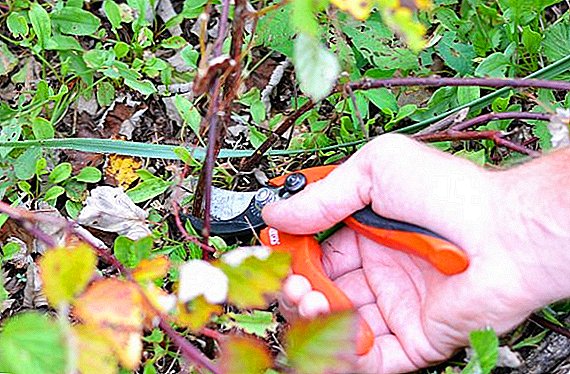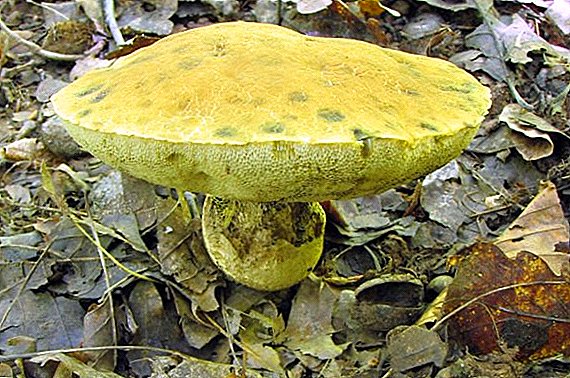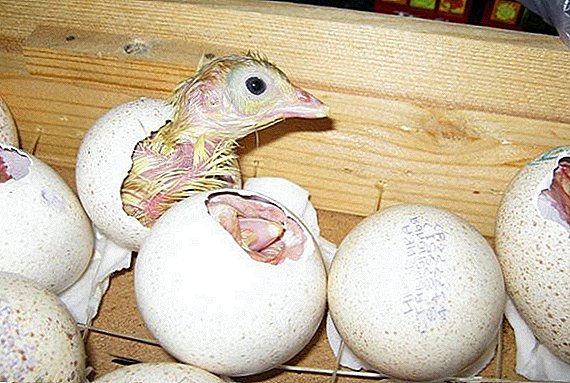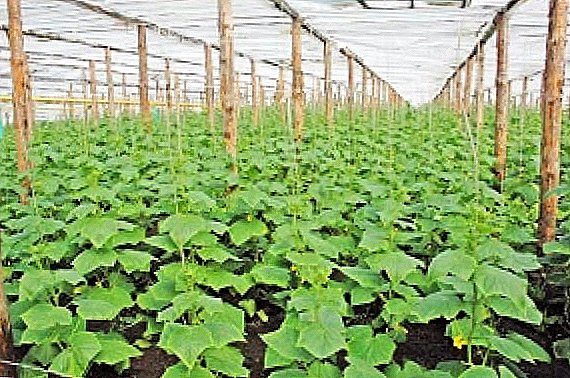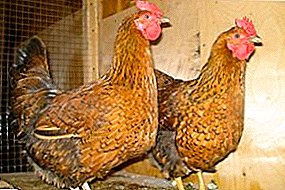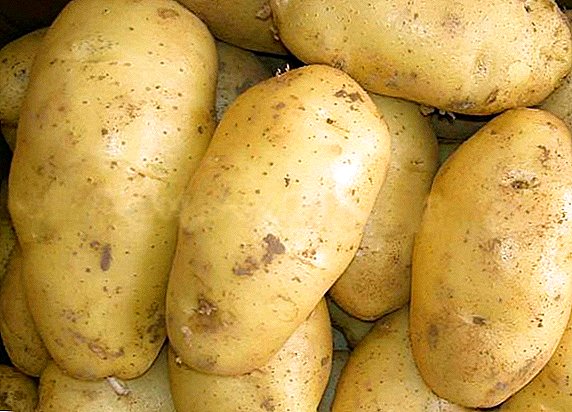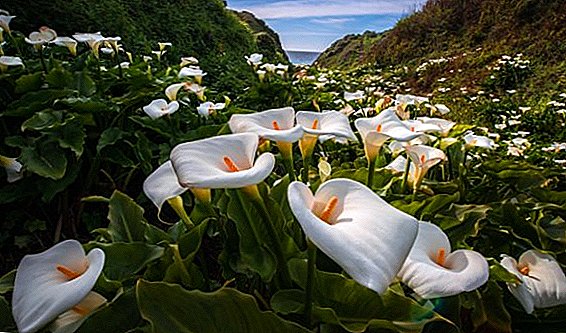 Calla - exotic plant, its birthplace is South Africa. In its natural environment, the plant prefers wetlands.
Calla - exotic plant, its birthplace is South Africa. In its natural environment, the plant prefers wetlands.
The flower was named Zantedesky in honor of the Italian botanist F. Zantedeschi. Despite the opinion that callas grow well only in greenhouses, the plant is successfully grown at home.
Ethiopian Calla (Calla aethiopica)
 The most popular form for growing - Ethiopian calla. These are tall white flowers with long dense leaves up to 45 cm long and 25 cm wide.
The most popular form for growing - Ethiopian calla. These are tall white flowers with long dense leaves up to 45 cm long and 25 cm wide.
The inflorescence of a yellow shade in length corresponds to a snow-white veil. The tubular bedspread at the base of the form gently expands to the apex.
Did you know? White flowers of calla are a symbol of purity and tenderness, apparently, that is why these flowers are so popular with brides. Newlyweds are presented with callas as a talisman, a guarantee of happiness and harmony in marriage.
"Amethyst"
 One of the varieties of Zantedeskii Ethiopian - "Amethyst". Depending on the conditions of detention, it grows from half a meter to 120 cm in height. On the background of large, dense emerald-green leaves stand tall flower stalks with a bright veil.
One of the varieties of Zantedeskii Ethiopian - "Amethyst". Depending on the conditions of detention, it grows from half a meter to 120 cm in height. On the background of large, dense emerald-green leaves stand tall flower stalks with a bright veil.
The petal coverlet is painted in violet shades, from pale lilac to rich violet color. On the very bottom of the bedspread you can see the ink-colored stain. This flower has a delicate and delicate aroma.
"Green Goddess"
 The bud of the low Green Goddess can be immediately overlooked. From the outside, it almost does not differ in color from juicy bright green leaves and stems.
The bud of the low Green Goddess can be immediately overlooked. From the outside, it almost does not differ in color from juicy bright green leaves and stems.
From the inside, the petal-bedspread is painted white, and on the edge, unevenly, in green. In addition, the flower has a short lemon stamen, which is not visible due to the high petal.
"Pearls"
 "Pearls" - type of pot callas. Tall plant with light leaves and stems. White flowers are shaded pale green on the outside.
"Pearls" - type of pot callas. Tall plant with light leaves and stems. White flowers are shaded pale green on the outside.
Flowers are long cut and have a delicate aroma. With a great desire and proper care can be grown in open ground.
"Little Jam"
 Another snow-white variety of callas - "Little Jam". A flower that does not fully bloom as in a cocoon has a yellow stamen hiding in a spiral-shaped bedspread.
Another snow-white variety of callas - "Little Jam". A flower that does not fully bloom as in a cocoon has a yellow stamen hiding in a spiral-shaped bedspread.
From the inside, at the base, the flower is colored yellow-green, the edge of the petal, which is bent with a peculiar claw, is remarkable.
"Nikolay"
 This variety is more suitable for outdoor cultivation. The plant reaches one and a half meters in height. The leaves have a pointed form of dark green saturated color.
This variety is more suitable for outdoor cultivation. The plant reaches one and a half meters in height. The leaves have a pointed form of dark green saturated color.
Long petioles and large, up to 12.5 cm in diameter, bedspread. The flower itself, like the leaves, is green.
"Pearl von Zweibrücken"
Yellow Calla Variety - grade "Pearl von Zweibrücken" grows to a meter. On the peduncle pale yellow flower, the stem of the stalk is greenish-yellow.
"Pearl von Stuttgart"
It is believed that this variety is more suitable for growing in greenhouses and greenhouses. A short peduncle, about 70 cm tall, topped with a yellow flower. The leaves of this calla are green with white patches.
"Schöne Zweibrückerin"
The length of the stem "Schöne Zweibrückerin" reaches a meter in height. The leaves are light green, the cover of the flower at the stem is dark yellow, slightly paler towards the top.
Calla Rehmannii
 Calla remmann - This is a short-lived type of calla. In height, the plant is no more than 50 cm. The leaves are green, narrow. In winter, the plant sheds leaves. The plant is tuberous, easily grown at home. Most varieties are colored pink.
Calla remmann - This is a short-lived type of calla. In height, the plant is no more than 50 cm. The leaves are green, narrow. In winter, the plant sheds leaves. The plant is tuberous, easily grown at home. Most varieties are colored pink.
Important! All parts of the calla are poisonous, if the juice comes in contact with the skin, it can cause burns and swelling. If there are animals and small children in the house, the plant should be placed higher and away from them: the juice can cause vomiting and swelling of the larynx.
"Evening"

The selection of callas Rähmann has given life to many species with rich shades. Calla "Evening" with inky-blue or black and purple flowers - a vivid confirmation of this. A bouquet composed of these and snow-white varieties of callas will look extraordinary.
"Indian summer"
Refined red calla attracts the eye with an uneven shade. The general background of the bedspread is red, but if you look at the flower from a certain angle, you can clearly see the shade of garnet.
"Chameleon"
 A short stalk will look organic at home. The small leaves of the plant are spotty green and white. Bright stems are decorated with iridescent peach and cream flowers, and in the bright sun they can be cast in gold.
A short stalk will look organic at home. The small leaves of the plant are spotty green and white. Bright stems are decorated with iridescent peach and cream flowers, and in the bright sun they can be cast in gold.
Attention! Growing a flower at home, remember that the land of callas is a hot continent. The plant needs regular watering and humidity, but do not overdo it, otherwise the plant will get sick.
Calla Elliottiana
The appearance of these callas is united by common features: large green leaves with specks and several shades of color, differing from the outer and inner side of the petal.
This type is preferable to propagate by tubers. Calla Elliot loves light and heat, favorably refers to frequent watering, being a moisture-loving calla.
"Vermeer"
 Calla "Vermeer" is distinguished by its special elegance due to the unusual coloring of both leaves and bud. On the carved wavy on the edge of the green leaves white spots are scattered randomly.
Calla "Vermeer" is distinguished by its special elegance due to the unusual coloring of both leaves and bud. On the carved wavy on the edge of the green leaves white spots are scattered randomly.
A sturdy, thick stem crowns a funnel-shaped multi-colored bedspread. At the very stem of a bud of dark lilac color, on the edge of the opened petal is painted with a white broad border.
Interesting! There is a belief that the calla embroidered on a piece of cloth, gifted to a dear person with some kind of baking, will save him from trouble, enlighten him to the right decisions and actions.
"Yellow Corner"
This type of callas has a yellowish shade of the stem and bright emerald leaves with a speck. The bedspread is juicy yellow, bright as the sun.
"Black-eyed beauty"
 The leaves of the "Black-eyed beauty" are covered with heels of irregular shape. A cover of a gentle cream shade, in the center at a stamen a spot of ink color.
The leaves of the "Black-eyed beauty" are covered with heels of irregular shape. A cover of a gentle cream shade, in the center at a stamen a spot of ink color.
Callas, due to the variety of colors, are very popular in floristics. They look great in compositions with different colors and a separate bouquet. On the plot of land calla can decorate the garden and in pot plantings, and in flowerbeds, and in a variety of decorative ensembles.


